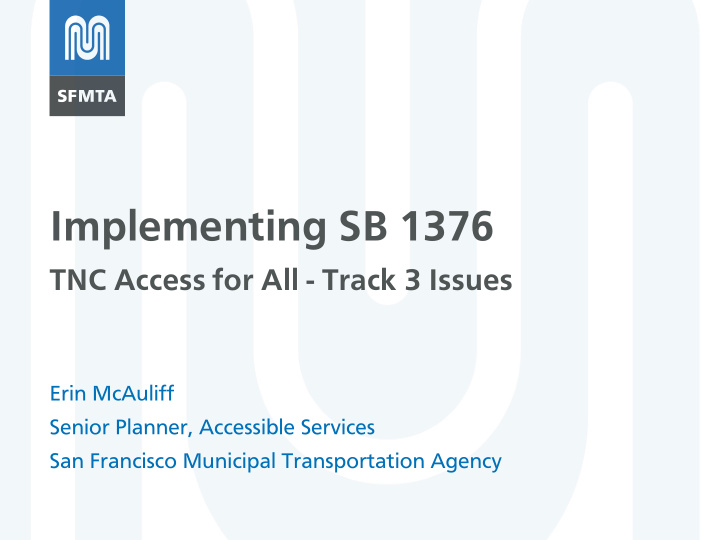



Implementing SB 1376 TNC Access for All - Track 3 Issues Erin McAuliff Senior Planner, Accessible Services San Francisco Municipal Transportation Agency
Track 3: Background and Goals • Finalize clear offset a and e exemption requirements that: 1. Demonstrate presence and availability of WAV service 2. Easily compare to service provided in standard vehicles • Provide flexible funding to access providers so that they can temporarily fill WAV s service gaps while TNCs build their capacity. • Engage local and national expertise: 1. Access fund administrators 2. Audit and evaluation
TNC OFFSET REQUIREMENTS Incremental Costs • Costs that are granted to be offset must specifically and explicitly improve WAV s service. • The burden i is n not on t the C Commission o or n non-TNC parties to “calculate” incremental costs or to create a “formula.” • In addition to required audit, the Commission should require TNCs to: • Identify the method for allocating those actual additional costs of WAV service • Certify that expenses documented on Appendix A reflect actual additional costs of WAV service
TNC OFFSET REQUIREMENTS Presence and Availability • Intent of SB1376: Wheelchair users who need WAVs have prompt access to TNC services. • Current requirements only evaluate accepted requests – This does not reflect user experience when only a small number of requests are fulfilled. • TNCs must demonstrate an improved level of service based on the percentage of requested trips completed and response times.
ACCESS FUND DISBURSEMENTS • Program needs and funding amounts will vary county to county. Criteria for access providers should be flexible to reflect input a and n needs of local disability community. • Commission should apply broad definition of “on demand transportation” so that AFAs can fund solutions that work for WAV riders in their county. • Requirements imposed on AFAs and SAFA must consider: • Administrators need stable and sufficient funding • Effective access providers will not always be regulated by the CPUC (e.g. taxicabs, NEMT, ADA and community paratransit providers)
REPORTING REQUIREMENTS • Research question: Are WAV users receiving continuously improved, reliable and available service? • Key benchmarks: : • Performance must be measured in relation to the general public TNC service in geographic area (percentage of requested trips completed and response times) • What progress, if any, have TNCs made toward providing equivalent service? • Data C Collection: • Trip Report, Vehicle Segment Report, Vehicle Report, Unique User Report • Transparency: Develop public d dashboard to inform prospective users and the general public.
Additional TNC Accessibility Issues • Many people with disabilities in San Francisco see promise in n new m mobility services, particularly TNCs, but face significant barriers to use. • Conduct meaningful o outreach to understand what is and is not working for passengers with disabilities. • TNCs can and should cooperate with government entities in providing accessible services.
Contact Information Erin McAuliff Senior Planner, Accessible Services San Francisco Municipal Transportation Agency ERIN.MCAULIFF@SFMTA.COM
Recommend
More recommend